Alaska Fish & Wildlife News
January 2007
Predators and Moose
Why Arent Moose Calves Surviving?
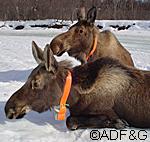
When the moose population began dropping in Game Management Unit 16B, many hunters and biologists suspected wolves and bears were primarily to blame. But without further study, no one knew if that hunch was correct. Perhaps poor moose productivity, disease, weather conditions or other factors might also be affecting the moose population in this region that stretches west from the Susitna River to the Alaska Range.
In the 1970s and ‘80s the moose population in Unit 16B was estimated to ...
Predators and moose ArticleContinued
Sport Fishing for Salmon Shark
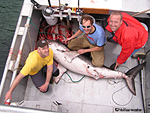
“We didn't think we'd really catch one!”
Reflecting on a successful salmon-shark fishing expedition outside Icy Strait, J.J. Vollenweider adds “I kind of doubt I'd do it again.”
One of the most powerful and aggressive of all sharks, they tend to range from six to nine feet long and weight between 250 and 400 pounds. Salmon shark's endothermic physiology makes them faster and more agile in cold water than other sharks. Keeping up this warm internal temperature is metabolically costly; ...
Shark Fishing ArticleContinued
No Avian Flu in Alaska
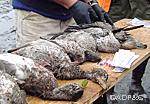
Now that the year has ended and all the results from various avian flu sampling efforts have returned from laboratories, scientists can safely conclude that Asian H5N1 was not found in Alaska in 2006.
At the beginning of the year, scientists were concerned that a highly pathogenic strain of bird flu, known as Asian H5N1, might show up first in Alaska and then spread into the rest of North America.
It appeared at the time that wild birds were capable of spreading the disease over ...
No Bird Flu in AK ArticleContinued
Ravens Suited to Urban Life in Alaska
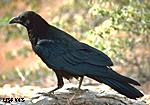
You know winter has Anchorage in her icy grip when you walk through a snowy parking lot and hear a shiny black raven croaking from a lamppost perch.
Even my 4-year-old understands the connection: The ravens are back; winter is here, he told me the other day.
Although several hundred ravens live in town during the summer, large groups of the birds return to Anchorage each winter for easy meals. These corvid family members typically arrive in late October, according to Alaska Department ...
Ravens ArticleContinued
Southern-style Crab Cakes
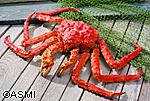
1 tablespoon olive oil
1 small red bell pepper, seeded and chopped
2 cloves garlic, chopped
1 small onion, chopped
1 tablespoon fresh parsley
1/3 cup mayonnaise
1 egg, lightly beaten
2 tablespoons lime juice
2 teaspoons Jamaican jerk seasoning
1 teaspoon dry mustard
1 teaspoon paprika
1 pound lump crabmeat, squeeze out excess liquid
salt and pepper to taste
2 cups fine dried bread crumbs
vegetable oil for frying
Saute bell pepper, ...
Crab cakes ArticleContinued
